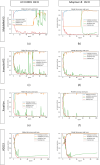Deep learning-based classification of alfalfa varieties: A comparative study using a custom leaf image dataset
- PMID: 39650117
- PMCID: PMC11625211
- DOI: 10.1016/j.mex.2024.103051
Deep learning-based classification of alfalfa varieties: A comparative study using a custom leaf image dataset
Abstract
Deep learning has profoundly impacted agriculture by enhancing the accuracy and efficiency of plant classification tasks. In particular, advanced models have significantly improved the ability to classify various plant species based on their visual features. This study focuses on classifying alfalfa plant varieties using deep learning techniques. We created a custom dataset comprising 1,214 images of three alfalfa varieties (Bilensoy-80, Diana and Nimet) cultivated under controlled conditions. Our comparative study involved several state-of-the-art models, including MobileNetV3, InceptionV3, Xception, VGG19, DenseNet121, ResNet101, and EfficientNetB3, to assess their performance in classifying these alfalfa varieties. We evaluated these models with various configurations: learning rates ranging from 0.1 to 0.000001, batch sizes of 8, 16, 32, and 64, and using dropout with a decay rate of 0.96 and decay steps of 1000. The results revealed that models trained with transfer learning generally achieved higher test accuracies. For instance, DenseNet121 achieved a test accuracy of 0.9945 when trained from scratch and 1.0000 with transfer learning, while EfficientNetB3 achieved a test accuracy of 0.9945 with both methods. The findings underscore the effectiveness of transfer learning in enhancing model performance for plant classification tasks.•The study introduced a unique dataset consisting of 1214 images of three alfalfa varieties (Bilensoy-80, Diana, and Nimet) cultivated under controlled conditions, providing a valuable resource for advancing plant classification research.•The research compared the performance of several state-of-the-art deep learning models (MobileNetV3, InceptionV3, Xception, VGG19, DenseNet121, ResNet101, and EfficientNetB3) with various hyperparameter configurations, demonstrating the effectiveness of different architectures for classifying alfalfa plant varieties.•The study highlighted the superior performance of transfer learning in plant classification tasks, with models like DenseNet121 and EfficientNetB3 achieving near-perfect accuracy, underscoring its potential to significantly enhance model accuracy and efficiency in agricultural applications.
Keywords: Alfalfa plant; Artificial Intelligence; Comparative Deep Learning Model Evaluation; Image classification; Model Evaluation; Plant Classification; Transfer Learning.
© 2024 The Authors.
Conflict of interest statement
The authors declare that they have no known competing financial interests or personal relationships that could have appeared to influence the work reported in this paper.
Figures








References
-
- Farshadfar M., Kakaei B.M., Salehabadi Y., Baghaeifar Z., Jafari A.A., Associate E.A. Study of diversity for yield and quality traits in Alfalfa (Medicago Sativa L.) and Determination of the Best Population for Cultivation in Dryland Farming in Iran. J. Rangeland Sci. (JRS) 2023;12 doi: 10.30495/RS.2022.682009. - DOI
-
- Tlahig S., Karmous I., Ayeb N., Atoui A., Seddik M., Yahia H., Dbara M., Rejeb M., Khorchani T., Loumerem M. Forage quality profiling of pre-selected alfalfa genotypes: towards genetic enhancement and adaptation for arid dryland farming. Euro. Mediterr J. Environ Integr. 2024 doi: 10.1007/S41207-024-00487-2. - DOI
-
- Köninger M., von Velsen-Zerweck A., Eiberger C., Löffler C., Töpper A., Visscher C., Reckels B. Vervuert, I. Nutrient composition and feed hygiene of Alfalfa, Comparison of Feed Intake and Selected Metabolic Parameters in Horses Fed Alfalfa Haylage, Alfalfa Hay or Meadow Hay. Animals. 2024;14 doi: 10.3390/ANI14060889/S1. - DOI - PMC - PubMed
-
- Baidoo M.M., Islam M.A. Potassium and harvest time interaction effect on alfalfa production and profitability. Agron. J. 2024 doi: 10.1002/AGJ2.21575. - DOI
-
- Varol I.S., Ünlükara A., Kaplan M. Water productivity, yield response factors, yield and quality of alfalfa cultivars in semi-arid climate conditions. Environ. Exp. Bot. 2024;224 doi: 10.1016/J.ENVEXPBOT.2024.105826. - DOI
LinkOut - more resources
Full Text Sources

